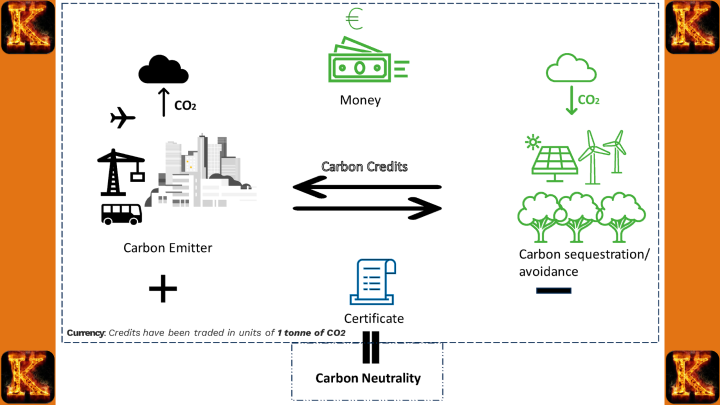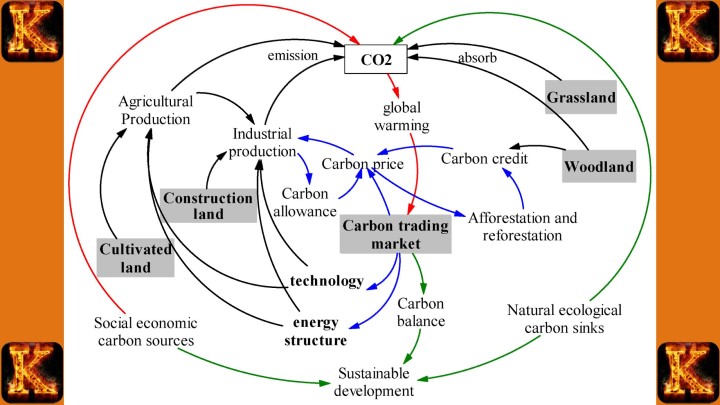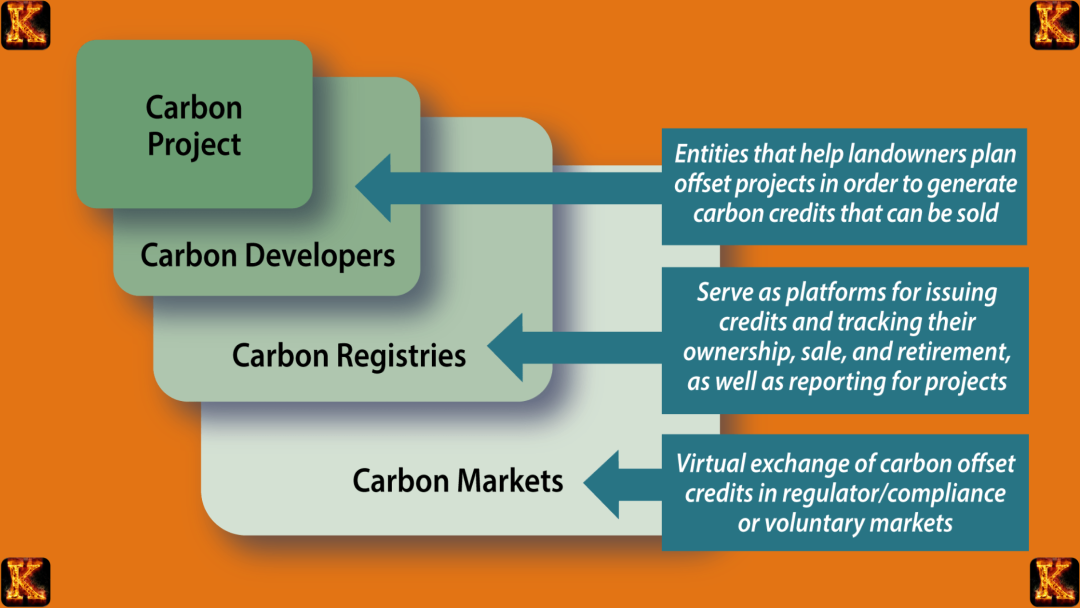Leveraging System Dynamics for Effective Climate Policy and Carbon Markets
The accelerating pace of climate change has made it imperative to adopt innovative, systems-based solutions for global carbon management. One of the most promising mechanisms is carbon credit trading, which allows for the buying and selling of carbon emission allowances to incentivize reduction efforts. To understand and optimize this system’s complexity, system dynamics offers a valuable modeling approach that integrates policy, behavior, feedback loops, and time delays. It helps forecast long-term outcomes, simulate market responses, and evaluate the systemic impact of climate interventions.
System dynamics climate change applications reveal that carbon markets are not static as they are influenced by economic decisions, regulatory shifts, and behavioral adaptations. Using a systems thinking and climate change framework allows analysts to trace how different elements namely policy thresholds, innovation rates, investment flows, and emission levels interact over time. These interactions can be simulated through climate modeling, which has become a critical tool in shaping effective, science-based carbon trading systems.
Educational programs and tools are increasingly adopting interactive climate change approaches to foster public understanding. The Simulating Climate Futures in En-ROADS Laboratory, for instance, uses climate modeling software to allow students, professionals, and policymakers to explore how pricing carbon, limiting fossil fuel subsidies, or introducing carbon taxes affect emissions. Such climate change simulations for students are integral to the Climate Change Ambassador Program, which trains youth leaders in sustainability, systems thinking, and environmental policy analysis.
To advance the real-world application of these models, universities and environmental agencies now integrate climate modeling into both policy research and academic curricula. With climate modeling tools, users can evaluate the efficacy of different carbon credit scenarios; whether market-based, voluntary, or regulatory, and test the resilience of climate strategies over decades.
What System Involves the Trading of Carbon Credits?
The carbon credits trading system is a market-based environmental and economic mechanism designed to incentivize the reduction of greenhouse gas (GHG) emissions by placing a monetary value on the right to emit carbon dioxide (CO₂) or equivalent gases. This system operates within broader climate governance frameworks, such as cap-and-trade systems, voluntary carbon markets, and carbon offset programs, which seek to internalize the environmental cost of emissions and drive investment toward sustainable solutions.
At its core, this system relies on the principles of supply and demand, economic incentives, and regulatory oversight. However, due to the complexity of climate systems, human behavior, and policy interactions, the system dynamics climate change approach is essential to understand and manage these variables over time. Through climate modeling, stakeholders can simulate emissions trajectories, credit saturation, price fluctuations, and compliance strategies to improve overall system performance.
Read Also: Community Based System Dynamics in Health Equity
How the Carbon Credits Trading System Works:
The carbon credits trading system is a cornerstone of market-based climate policy, designed to incentivize emission reductions through financial mechanisms. It involves the allocation, trading, and retirement of carbon credits, each representing the right to emit one metric ton of CO₂ or its equivalent. There are three primary operational models: Cap-and-Trade, Voluntary Carbon Markets, and Carbon Offset Markets. Each operates with different rules, levels of regulation, and stakeholder participation but shares the goal of reducing net greenhouse gas emissions.
Using system dynamics climate change models, we can simulate how these systems behave over time, test the impact of different cap levels, and assess the effectiveness of policy instruments in various economic and environmental scenarios.
1. Cap-and-Trade Model (Regulated Market)
The cap-and-trade system is a legally binding regulatory framework adopted by governments to ensure collective emission reductions while maintaining economic flexibility.
Key Mechanisms:
-
Cap Setting:
-
A government or regulatory authority establishes a cap on the total greenhouse gas emissions allowed for a specific sector or economy.
-
The cap typically declines annually to align with national or international climate targets.
-
-
Allowance Allocation:
-
Entities such as power plants, airlines, or manufacturers receive emission allowances (carbon credits), either for free or via auctions.
-
Each allowance permits the emission of a fixed quantity of CO₂e.
-
-
Trading System:
-
Organizations that emit less than their allowance can sell excess credits.
-
Organizations that exceed their allowance must purchase additional credits or face penalties.
-
-
Market Dynamics:
-
Credit prices fluctuate based on market supply and demand.
-
Over time, the declining cap creates scarcity, raising credit prices and encouraging technological innovation.
-
Example Programs:
-
EU Emissions Trading System (EU ETS)
-
California Cap-and-Trade Program
-
Regional Greenhouse Gas Initiative (RGGI) in the U.S.
Role of Climate Modeling and System Dynamics:
-
Simulates feedback loops (e.g., high prices → low emissions → credit surplus → price drop).
-
Evaluates long-term price trajectories, policy efficiency, and investment behavior.
-
Assists in designing stability mechanisms like price floors, market reserves, or banking/borrowing credits.
2. Voluntary Carbon Markets (VCMs)
Unlike cap-and-trade systems, voluntary carbon markets are non-regulated platforms where individuals, companies, or institutions offset their carbon footprints voluntarily.
Key Features:
-
Purpose-Driven Offsetting:
-
Used by entities seeking to meet corporate social responsibility (CSR) goals, achieve carbon neutrality, or appeal to environmentally conscious consumers.
-
-
Credit Generation:
-
Carbon credits are created through certified projects that avoid, reduce, or sequester emissions.
-
Common projects include:
-
Reforestation
-
Renewable energy installations
-
Improved cookstove distribution
-
Methane capture from landfills or livestock operations
-
-
-
Project Certification:
-
Standards such as Verra’s Verified Carbon Standard (VCS), Gold Standard, or American Carbon Registry are used to ensure additionality, permanence, and transparency.
-
-
Buyers:
-
Corporations, travel companies, universities, and event organizers purchase credits to offset specific emissions (e.g., business travel, events).
-

Pros:
-
Encourages early climate action beyond regulation.
-
Supports sustainable development in low-income regions.
Cons:
-
Less oversight than regulated markets → risk of greenwashing.
-
Variable credit quality and pricing.
System Dynamics and Interactive Climate Tools:
-
Climate modeling is used to simulate future market growth, credit reliability, and potential saturation.
-
Climate change simulation for students often includes VCM scenarios to teach carbon budgeting and stakeholder dynamics.
3. Carbon Offset Markets (Offset Mechanisms in Both Regulated and Voluntary Contexts)
Carbon offset markets function as a bridge between carbon emitters and emission reduction or removal projects, offering flexibility in compliance or corporate sustainability strategies.
Offset Project Types:
-
Avoidance: Preventing deforestation, preserving peatlands.
-
Reduction: Energy-efficient upgrades, fuel-switching projects.
-
Sequestration: Soil carbon improvement, agroforestry.
-
Removal: Direct air capture, biochar, enhanced weathering.
Application Contexts:
-
Used in both regulated markets (e.g., CORSIA for aviation) and voluntary markets.
-
Common among:
-
Airlines
-
Tech firms with net-zero commitments
-
Global supply chain networks
-
ESG-focused investment portfolios
-
Role of Climate Modeling:
-
Models carbon lifecycle analysis to assess project impact.
-
Assesses offset integrity using criteria like:
-
Additionality (project wouldn’t occur without credit funding)
-
Permanence (carbon stays sequestered long-term)
-
Leakage (reductions don’t cause emissions elsewhere)
-
Use in Education and Policy Training:
-
Programs like the Climate Change Ambassador Program incorporate interactive climate change simulations with offset decision-making exercises.
-
Tools like Simulating Climate Futures in En-ROADS Laboratory include offsets in evaluating long-term climate scenarios.
Also Read: Writing a PhD Thesis Defense Paper
Why Use System Dynamics in Carbon Credit Trading?
The carbon credit trading system operates within a complex web of economic incentives, environmental impacts, regulatory mechanisms, and human behavior. As such, traditional linear models often fail to capture its full dynamics over time. System dynamics climate change models offer a comprehensive solution by providing a way to simulate and understand the interactions between these components, enabling more robust decision-making and policy design.
System dynamics is particularly useful in this context because it focuses on feedback loops, delays, accumulations (stocks), and flows. The key characteristics of both carbon markets and climate systems. By applying this methodology to carbon credit trading, stakeholders can test policies, identify unintended consequences, and better forecast long-term environmental and economic outcomes. It bridges the gap between environmental science, economics, and systems thinking, helping both students and decision-makers visualize how today's actions shape tomorrow's climate.
Key Reasons to Use System Dynamics in Carbon Credit Trading:
1. Captures Feedback Loops
-
Carbon markets are dynamic, meaning their behavior changes in response to both internal and external factors.
-
Example: A drop in emissions can lead to lower demand for carbon credits, which in turn reduces credit prices. Cheaper credits may discourage further emission reductions, creating a feedback loop.
-
System dynamics models simulate these loops to:
-
Prevent destabilizing trends.
-
Identify where policy intervention is needed.
-
Design price floors, market stability reserves, or credit banking rules to smooth volatility.
-
2. Simulates Policy Interventions
-
Policymakers can use system dynamics models to test the effectiveness of different climate policies before implementing them.
-
Simulation tools allow users to:
-
Adjust cap levels or emission allowances.
-
Alter credit eligibility criteria (e.g., excluding certain offset types).
-
Explore how verification timelines or compliance rules influence credit markets.
-
-
Integrated into interactive climate change platforms like the En-ROADS Laboratory, this allows for fast, visual testing of various scenarios with immediate feedback.
3. Analyzes Delays and System Resistance
-
Real-world systems experience delays:
-
Policy delays: Time between legislation and enforcement.
-
Technology adoption delays: Time needed for businesses to transition to cleaner solutions.
-
Behavioral inertia: Resistance to change due to costs, habits, or lack of awareness.
-
-
System dynamics climate change models incorporate these delays, helping:
-
Forecast when actual emissions reductions will be visible.
-
Avoid overly optimistic or pessimistic projections.
-
Model transition pathways with realistic timeframes.
-
4. Supports Climate Education and Diplomacy
-
System dynamics tools like climate modeling software are critical in educational and diplomatic settings.
-
Climate change simulations for students, such as those in the Climate Change Ambassador Program, teach:
-
Systems thinking.
-
Policy impacts on climate futures.
-
-
Tools like Simulating Climate Futures in En-ROADS Laboratory enable:
-
Interactive exploration of carbon pricing and credit trading models.
-
Collaborative learning among policymakers, students, NGOs, and private sector leaders.
-
Using system dynamics in carbon credit trading provides far more than just numerical forecasts. It offers a strategic systems-thinking framework to evaluate decisions, simulate future outcomes, and design more resilient, fair, and effective carbon markets. By incorporating tools like climate modeling, stakeholders can ensure that carbon credit systems contribute meaningfully to long-term climate goals, while avoiding policy failures, market crashes, or superficial sustainability claims like greenwashing.

What Are the Four Types of Carbon Credits?
In carbon markets, not all carbon credits are created equal. There are four primary types of carbon credits, each contributing differently to emissions mitigation and playing a distinct role in the carbon credit trading system. The effectiveness of these credits, whether environmentally and economically, can be evaluated through climate modeling and system dynamics climate change frameworks.
These tools help model how credit types interact with market forces, feedback loops, and policy decisions over time. Importantly, they also help detect risks such as greenwashing, where credits are used to mask inadequate climate action.
1. Avoidance Credits
These credits are generated by preventing emissions that would otherwise occur.
-
Examples:
-
Stopping deforestation (preserving carbon sinks)
-
Avoiding methane emissions from landfills
-
Protecting peatlands and wetlands
-
-
System Dynamics Insight:
-
Avoidance projects may show diminishing returns over time if not coupled with structural land use reform.
-
Climate modeling can simulate tipping points where deforestation rates surpass the system’s capacity to regenerate forests.
-
-
Risks:
-
Verifiability and permanence concerns (e.g., forest fires or illegal logging).
-
Potential leakage if emissions are simply displaced elsewhere.
-
2. Reduction Credits
These represent measurable decreases in current emissions through process or efficiency improvements.
-
Examples:
-
Installing energy-efficient machinery
-
Transitioning to LED lighting in industrial facilities
-
Switching from diesel to electric in public transport fleets
-
-
System Dynamics Insight:
-
Reduction credits often depend on behavior and investment cycles, thus delaying uptake can be simulated using feedback and delay structures.
-
Interactive climate change models can help forecast long-term reduction outcomes across sectors.
-
-
Advantages:
-
Easier to quantify and track.
-
Stronger potential for co-benefits like cost savings and air quality improvement.
-
3. Sequestration Credits
These credits are earned by capturing and storing atmospheric carbon in natural systems.
-
Examples:
-
Reforestation and afforestation
-
Soil carbon enrichment through regenerative agriculture
-
Mangrove restoration and kelp farming
-
-
System Dynamics Insight:
-
Sequestration timelines are long and climate modeling can evaluate the permanence risk of stored carbon re-entering the atmosphere.
-
Natural sequestration is influenced by climate variability, which must be incorporated into simulation models.
-
-
Key Considerations:
-
Need strong monitoring, reporting, and verification (MRV) systems.
-
Carbon saturation and ecological feedback must be included in climate change simulation for students and policy labs.
-
4. Removal Credits
These credits are awarded for actively removing carbon dioxide from the atmosphere using advanced technologies.
-
Examples:
-
Direct Air Capture (DAC) with geological storage
-
Enhanced weathering of minerals
-
Bioenergy with Carbon Capture and Storage (BECCS)
-
-
System Dynamics Insight:
-
Removal credits are highly capital-intensive, with steep technological learning curves.
-
Climate-economic models and Simulating Climate Futures in En-ROADS Laboratory scenarios help forecast when removal becomes economically viable at scale.
-
-
Strengths:
-
High additionality and permanence when properly managed.
-
Essential for achieving net-zero goals after emissions have been reduced as far as possible.
-
Modeling Credit Portfolios: Why It Matters
Using climate modeling and system dynamics, researchers and policymakers can:
-
Simulate different credit mixes to evaluate overall climate effectiveness.
-
Identify unintended consequences (e.g., overreliance on avoidance credits).
-
Forecast long-term carbon price stability.
-
Avoid greenwashing by ensuring credits meet standards of:
-
Permanence – Carbon stays removed/sequestered over decades.
-
Additionality – The action wouldn’t have occurred without credit revenue.
-
Verifiability – The carbon impact is measurable and traceable.
-
Thus, climate modeling software and system dynamics climate change approaches are crucial for assessing the integrity and impact of each carbon credit type. For students, educators, and professionals engaged in the Climate Change Ambassador Program or interactive climate change simulations, understanding these distinctions is foundational to credible, science-based climate action.
Conclusion: Building Climate Resilience with System Dynamics and Climate Modeling
In summary, applying system dynamics to carbon credit trading offers powerful insights into how we manage the economy-climate interface. It allows us to simulate market behaviors, policy reactions, and environmental feedbacks with precision. Through climate modeling, we can evaluate future risks, avoid design flaws, and accelerate global progress toward net-zero emissions.
Educational tools like the Climate Change Ambassador Program, interactive platforms like Simulating Climate Futures in En-ROADS Laboratory, and student-focused climate change simulations bring these models to life. For students navigating this space, Kector.com, MyAssignmentHelp.com, and WritersPerHour.com remain top-tier platforms for academic support, offering custom assistance on everything from system dynamics climate change essays to complex climate modeling assignments.

